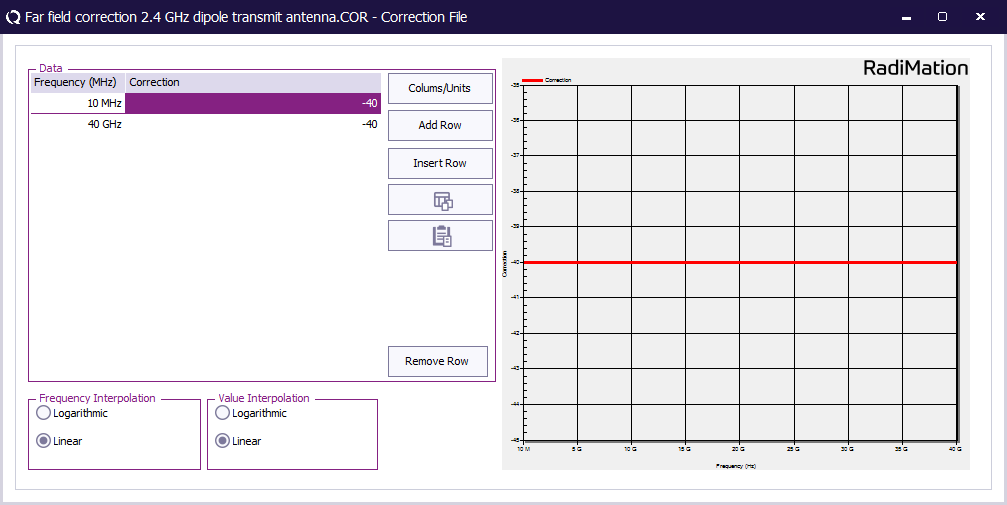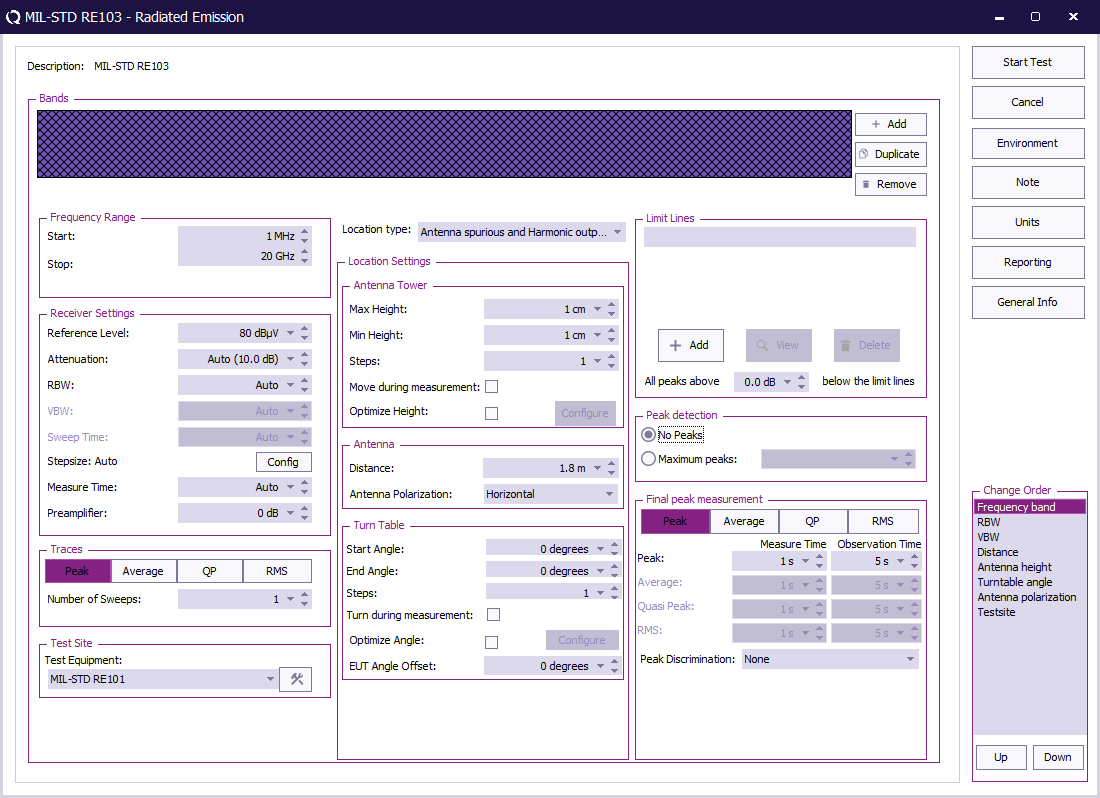RadiMation Application Note 162: Difference between revisions
| (6 intermediate revisions by the same user not shown) | |||
| Line 15: | Line 15: | ||
== Correction files == | == Correction files == | ||
=== Calculate the correction value for the far field === | |||
For the correct calculation of the ERP value the distance (R) is determined. See section 5.19.3.4a for details.<br> | For the correct calculation of the ERP value the distance (R) is determined. See section 5.19.3.4a for details.<br> | ||
In this example a transmitter dipole antenna for 2.4 GHz is used which is smaller than the | In this example a transmitter dipole antenna for 2.4 GHz is used which is smaller than the receive antenna. | ||
<math>R = \frac{2D^2}{\lambda}</math> | In this case we can use the following formula to calculate the far field distance <math>R = \frac{2D^2}{\lambda}</math> | ||
where: | where: | ||
* <math>D</math> is the diameter of the antenna. | * <math>D</math> is the diameter of the antenna. | ||
| Line 29: | Line 30: | ||
In this case the value to correct for is: | In this case the value to correct for is: | ||
<math> 20 \log(0.0625) = -40 \text{ dB} </math> | <math> 20 \log(0.0625) = -40 \text{ dB} </math> | ||
=== Create a correction file for the far field correction value: === | |||
{{Menu|File|New|Correction}} | |||
First create a correction file in {{RadiMation}} and specify the value of -40 for the applicable frequency range. | |||
[[File:RE103_far_field_correction.png]] | |||
Save the correction file on disk and attach it to cable driver that will be used in the test equipment. | |||
== EUT Testing == | == EUT Testing == | ||
Latest revision as of 15:33, 13 February 2025
How to perform a MIL-STD-461 RE103, radiated emissions, antenna spurious and harmonic outputs test[edit]
This application note explains how the MIL-STD-461 RE103, radiated emissions, antenna spurious and harmonic outputs test can be performed with RadiMation®.
The "RE103, radiated emissions, antenna spurious and harmonic outputs" test applies as an alternative to CE106 for testing transmitters with their intended antennas, ensuring emissions do not exceed RE102 limits in transmit mode. It is preferred for systems with active antennas or non-standard impedance curves. It applies from 10 kHz to 40 GHz, excluding the signal bandwidth and ±5% of the fundamental frequency, with larger exclusions for high-power Navy shipboard systems.
The exact requirements and test methods for the RE103 are specified in the MIL-STD-461.
Necessary equipment[edit]
The following devices should be configured:
- Measurement receiver
- Band rejection network
- Attenuators / filters
- Antenna
Correction files[edit]
Calculate the correction value for the far field[edit]
For the correct calculation of the ERP value the distance (R) is determined. See section 5.19.3.4a for details.
In this example a transmitter dipole antenna for 2.4 GHz is used which is smaller than the receive antenna.
In this case we can use the following formula to calculate the far field distance
where:
- is the diameter of the antenna.
- is the wavelength.
R = 6.25 cm = 0.0625 meters
To calculate the value for the correction file use the following formula: The outcome of this formula should be used in a correction file.
In this case the value to correct for is:
Create a correction file for the far field correction value:[edit]
-
 File
File
-
 New
New
-
 Correction
Correction
-
-
-
First create a correction file in RadiMation® and specify the value of -40 for the applicable frequency range.
Save the correction file on disk and attach it to cable driver that will be used in the test equipment.
EUT Testing[edit]
EUT Testing equipment
The configuration of the eut testing test site should contain the following devices:
| # | Device name | Tab in test site configuration window | note |
|---|---|---|---|
| Antenna | Devices 1 | The receiving antenna to use | |
| Spectrum analyser | Devices 2 | The measurement receiver or spectrum analyser to use | |
| Cables | |||
| ① | Cable preamp-> analyser | Cables | Cable with a correction file specified for the band rejection filter or high pass filter |
| ② | Cable preamp-> analyser | Cables | Cable with the specified loss of the used attenuator |
| ③ | Cable preamp-> analyser | Cables | Cable with a correction file specified for cable loss |
Configure the EUT test[edit]
To perform the eut test, create a radiated emissions multiband test. The radiated emission multiband test, can be started by selecting from the menu:
-
 Tests
Tests
-
 Radiated Emission
Radiated Emission
-
 Multiband
Multiband
-
-
-
| The start frequency of the test. For example 1 MHz. |
| The stop frequency of the test. For example 20 GHz. |
| The reference level set in the analyser. This setting is not used when a receiver is used. |
| The attenuation set in the receiver. |
| The RBW set in the receiver. |
| The step size set in the receiver. |
| The measure time set in the receiver. |
| The preamplifier setting set in the receiver. |
| The type of trace set in the receiver. For MIL-STD-461 RE103 the peak detector is used. |
| The equipment used for the measurement. |
| The type of measurement that should be used. Set this to Antenna spurious and harmonic outputs. |
| The maximum height for the antenna tower. |
| The minimal height for the antenna tower. |
| The number of height positions to measure. |
| If the antenna tower can move during the measurement. |
| Find the optimal emission around a certain height. This is normally not used during MIL-STD-461 RE103 measurements, and can thus be unchecked. |
| The distance between the antenna and the EUT. The antenna distance determined in 5.19.3.4a. |
| Which polarization is used, Vertical, Horizontal or Both. |
| The minimal turn table angle. |
| The maximum turn table angle. |
| The number of angles to measure. |
| If the turn table can move during the measurement. This is normally not used during MIL-STD-461 RE103 measurements, and can thus be unchecked. |
| Find the optimal emission around a certain angle. This is normally not used during MIL-STD-461 RE103 measurements, and can thus be unchecked. |
| The offset of the EUT on the table. This is normally not used during MIL-STD-461 RE103 measurements, and can thus be set to 0 degrees. |
| The applicable limit line can be added, in this example the "MIL-STD-461 RE102 XXX-XXX" limit line file. |
| Which level above x dB below the limit line the peaks should be detected. |
| How many peaks should be detected automatically. For a MIL-STD-461 RE103 peaks will be selected manually |
| It is possible to perform a final measurement on a peak with the selected detectors. Normally no final measurement is needed for the MIL-STD-461 RE103 measurement, and all detectors can thus be unselected. |







